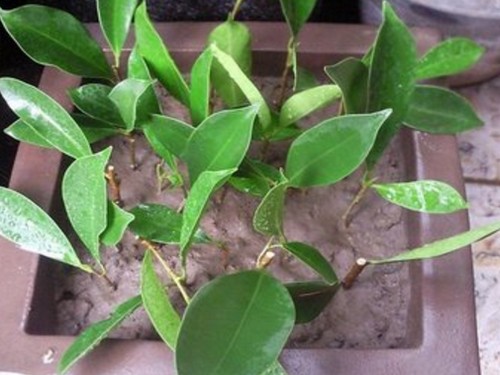Grafting technique of banyan bonsai
The ordinary banyan tree has unique "three beauties", that is, the beauty of air root, the beauty of root and the beauty of root. But the disadvantage is that the leaves are large, at the same time the distance between leaves is 2.4 cm, and the crown is loose. Selecting small-leaf banyan as scion for grafting can change the above defects and form small banyan pile bonsai.
Rootstock culture and scion selection:
Ginseng banyan is propagated by sowing, the thicker tuber root can be grown at the base of 3 years old, and the aerial lateral root can be grown on the tuber root. Ordinary banyan is propagated by pressing or cutting, and it usually takes more than 5 years to cultivate the old pile. The old naturally growing root pile can also be dug, and the root pile should be cut short one year before grafting, so that exuberant branches will grow on the root pile, and the branchlets should be sparse, and then grafted after one year of cultivation. The scion is Indian banyan, Thai banyan and the newly introduced American banyan.
Grafting methods and management:
Grafting occurs for a long time when budding occurs in early spring. In order to make the interface at the base of the branch, the multi-head ventral connection method can be used. The scion with 1-2 leaves and lateral buds was inserted into the rootstock and bound with plastic strips. Each branch is connected with one head, and generally 3-year-old ginseng banyan can have 3-5 heads. After grafting, the rootstock should be cut, the 20 cm long branches of the rootstock should be left on the interface, the leaves should be retained, and the tender shoots should be cut off. After that, put the pots together with plastic bags to keep the humidity and the temperature at about 25 ℃.
7 days after grafting, cut a small hole in the plastic bag and ventilate it properly. The plastic bag can be taken off after 15 days. When the scion grows obviously, cut off the rootstock above the joint, unbind it at the same time, and then tie it with a new plastic strip. Plastic strips should be loosened, because plastic strips can moisturize, promote callus growth, flatten the wound and have no dead tissue, which can improve the ornamental value of bonsai.
Banyan grafting is widely used in the rapid replacement of banyan varieties, the rapid production of banyan bonsai and the rapid rejuvenation of aging trees. The grafting period of banyan tree is appropriate before and after the Spring Festival order is made in January or from the middle of June to the end of July (from Grain in Beard to Greater Heat).
When grafting, the rootstock is truncated in the appropriate position, the lower branches and buds are removed but some old leaves should be retained, and then the sturdy and full one-year-old branches with leaves taken around the young and middle-aged trees in the surrounding area are used as scions. The branches that are about to sprout are selected for grafting in early spring, and the top and tender parts should be removed in high temperature in summer, and then the top is tightly sealed with plastic film. After removing the 2 + + 3 leaves, split grafting, skin grafting and ventral grafting were used.
After the grafting, the plastic film strip was wrapped tightly, and then an appropriate amount of cement mass was wrapped in the grafting site as a moisturizing material. finally, the scion and the grafting site were covered with a plastic bag, and the mouth of the plastic bag was bound and sealed by the tree trunk below the grafting position.
Time: 2019-06-12 Click:
- Prev

Grafting technique of Pinus elliottii Bonsai
Grafting of Pinus elliottii has been on the rise for a long time, because this technology is simple, low-cost and effective, so grafting has been very common. Although the technique is simple and easy to learn, the survival rate of grafting is not high at present. Some of them are lack of affinity because of the variety difference between scion and old pile.
- Next

Propagation methods of potted banyan trees
The banyan tree is an evergreen plant of Moraceae, with elegant and huge crown and air root, which can bear both shade and yang, moisture and drought, many varieties and easy shaping. It is an excellent tree species for soil and water conservation, urban greening and bonsai production. The common propagation methods of banyan trees are cutting, pressing, burying, etc., in the greenhouse in the north.
Related
- Fuxing push coffee new agricultural production and marketing class: lack of small-scale processing plants
- Jujube rice field leisure farm deep ploughing Yilan for five years to create a space for organic food and play
- Nongyu Farm-A trial of organic papaya for brave women with advanced technology
- Four points for attention in the prevention and control of diseases and insect pests of edible fungi
- How to add nutrient solution to Edible Fungi
- Is there any good way to control edible fungus mites?
- Open Inoculation Technology of Edible Fungi
- Is there any clever way to use fertilizer for edible fungus in winter?
- What agents are used to kill the pathogens of edible fungi in the mushroom shed?
- Rapid drying of Edible Fungi

